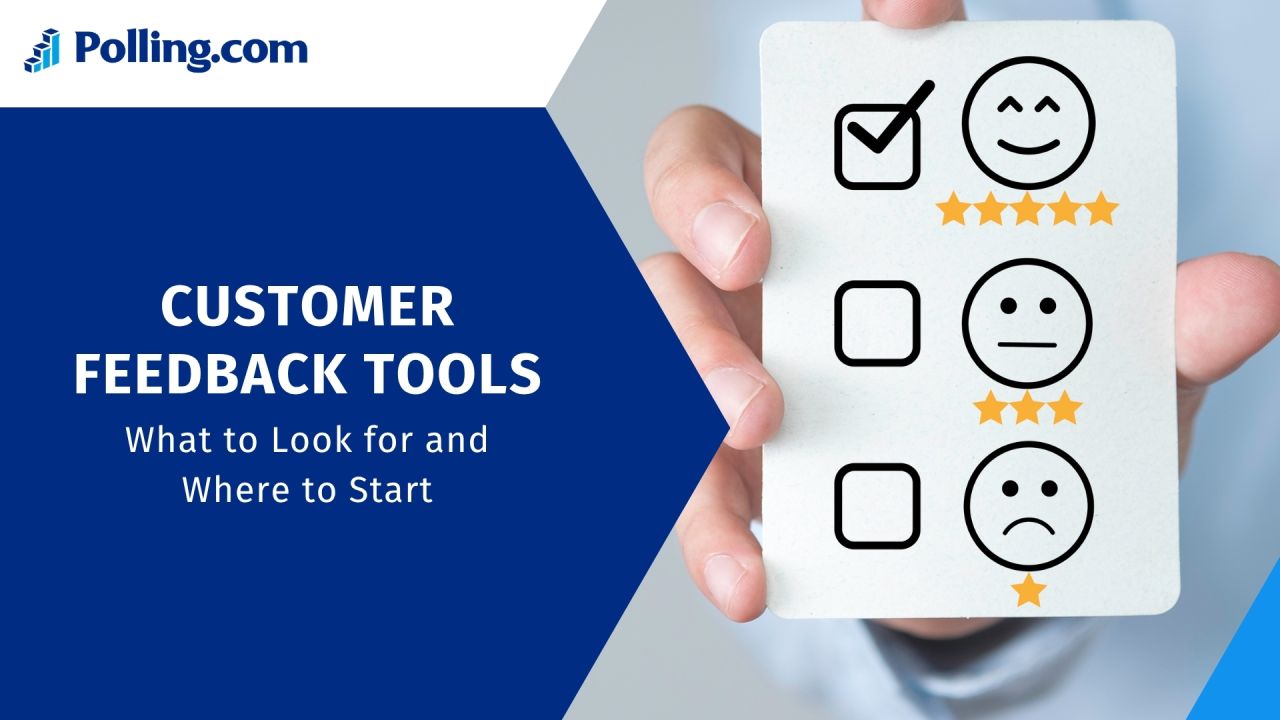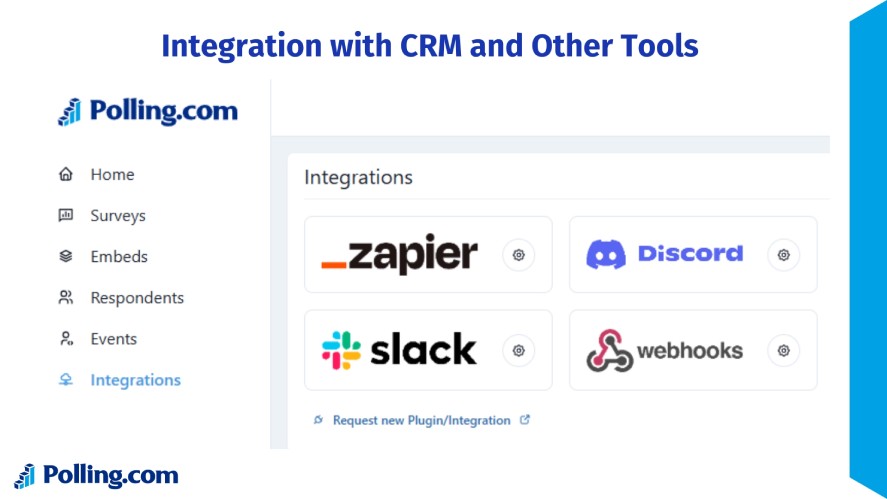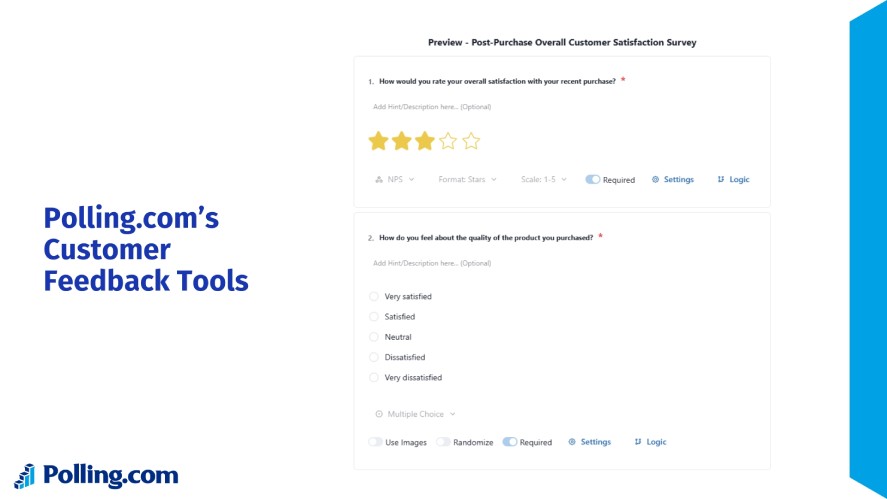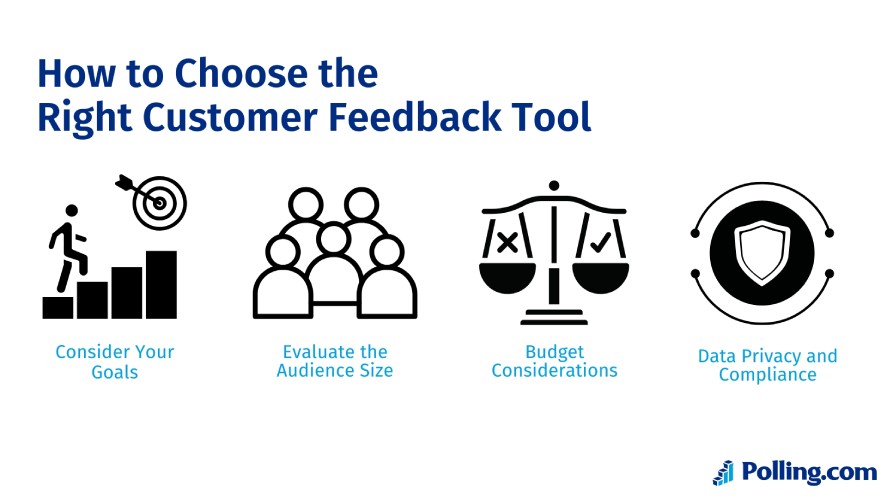
Customer Feedback Tools: What to Look for and Where to Start
In today’s fast-paced business environment, customer feedback has become a cornerstone for growth. It’s no longer enough to guess what your customers want—successful businesses actively listen, gather insights, and adapt accordingly.
That’s where customer feedback tools come in. These online feedback platforms transform scattered opinions into clear, actionable insights, helping you improve your services, products, and overall customer satisfaction.
Among the leading options, Polling.com stands out for its intuitive design and real-time analytics, making it a top choice for efficiently collecting and analyzing feedback.
Let’s explore how customer feedback tools can empower your business to grow smarter and faster.
What Are Customer Feedback Tools?
Customer feedback tools are software solutions that assist businesses collect, manage, and evaluate customers’ thoughts. They simplify the process of understanding customer experiences and identifying areas for improvement.
These survey tools and customer review collection apps gather input through a variety of channels, including:
- Surveys
- Product reviews
- Social media comments
- Net Promoter Score (NPS) assessments
While passive feedback like online reviews offers some insight, structured feedback, such as targeted survey responses, is far more actionable.
For instance, a well-designed survey that gathers 200 responses about your checkout process can highlight specific issues far more effectively than scattered social media comments.
Key Features to Look for in Customer Feedback Tools
The right surveying tool can make all the difference.
Whether you’re a startup or a large enterprise, look for these essential features to ensure the platform meets your needs.
Customizable Survey Templates
The best survey tools offer ready-to-use templates that can be tailored to your brand and goals.
Whether it’s an NPS, CSAT, employee feedback form, or customer feedback form, customization ensures you’re asking the right questions in the right way.
Real-Time Analytics and Reporting
Fast insights lead to fast decisions. Employee survey tools with real-time analytics and dashboards allow you to monitor trends instantly.
For example, quickly seeing that 65% of 300 customers rated your support team highly. This agility helps you respond to feedback before issues escalate.
Integration with CRM and Other Tools
Integration is key for a seamless workflow.

When your feedback tool connects with platforms like Salesforce or HubSpot, your team can easily track customer sentiment throughout the journey, automating design surveys after purchases or support interactions.
Multi-Channel Distribution (Email, Web, SMS)
Meeting customers where they are increases response rates.
The best tools support multiple distribution channels, like email, web pop-ups, or SMS, so you can capture feedback at every touchpoint, from post-purchase to customer support.
Scalability and User-Friendliness
As your business grows, your feedback survey tool should scale with you. Look for platforms that can handle increasing data volumes and support complex needs.
At the same time, user-friendly features, like drag-and-drop survey builders, to ensure anyone on your team can create and manage surveys with ease.
Top Customer Feedback Tools in 2025
Below is an enhanced overview of the leading online survey tools for gathering customer feedback this year, with Polling.com leading the pack.
Polling.com
Polling.com offers an exceptionally intuitive interface and flexibility for both individuals and small teams. Its free tier allows unlimited polls and interactive forms, no credit card required.

Real-time analytics and sophisticated customer insight dashboards give quick, meaningful insights, while AI-powered features let you budget responses and control usage without unexpected charges.
This makes Polling.com the top choice for fast, clear feedback loops.
SurveyMonkey
A veteran in the space, SurveyMonkey provides a robust survey-builder with detailed logic, benchmark comparisons, and team-sharing capabilities.
Its basic free plan allows up to 10 questions per survey and 25 responses. Paid team plans start at around $25 per user per month, unlocking advanced reporting, unlimited questions, and over 50,000 responses per year.
Typeform
Typeform stands out among user experience survey tools for its visually engaging, conversational design.
The free tier is limited, but the Basic plan starts at $29/month for 100 responses. The Plus plan ($59/month) scales to 1,000 responses and includes features like file uploads.
It supports 300+ integrations, customizable branding, and HIPAA/GDPR compliance—ideal for teams prioritizing user experience.
Qualtrics
Qualtrics is known for its enterprise-grade analytics and AI-driven insights.
While it offers a limited free plan (500 responses), its self-serve paid tier starts at $420/month for 1,000 shared responses.
Its agentic AI allows proactive engagement, such as real-time surveys that trigger follow-ups or customer support actions. Qualtrics is best suited to large organizations or research-heavy teams.
Google Forms
For basic data collection, Google Forms is hard to beat: it’s completely free, easy to use, and integrates smoothly with Google Sheets.
However, it’s limited in logic flows, branding, and advanced analytics, making it less suitable for deeper customer insights.
How These Customer Feedback Tools Compare
Below is the comparison of the top free survey tools for businesses and individuals looking to collect feedback efficiently, with a focus key features and integrations.
| Feature | Polling.com | SurveyMonkey | Typeform | Qualtrics | Google Forms |
|---|---|---|---|---|---|
| Analytics & Reporting | Real-time dashboards | Benchmarks, exportable data | Clear but simple | Advanced AI & agentic insights | Basic |
| Branding & Customization | High flexibility | Moderate | High | Enterprise-level | Very limited |
| Logic & Branching | Yes | Yes | Yes | Yes | Basic |
| Integrations | Moderate | Wide (CRM, Zapier) | 300+ integrations | Extensive (CX ecosystem) | Google Suite & Zapier support |
Why Polling.com Stands Out
Polling.com is built to serve both businesses and individuals with a focus on simplicity, power, and results.
Its free customer feedback tools are highly customizable, allowing users to tailor everything from branding to logic flows without a steep learning curve.
Advanced analytics and data visualization options make it easy to extract meaningful insights from raw data. Whether you’re gathering customer sentiment, employee feedback, or in-game player reactions, Polling.com turns responses into clear, actionable direction.
Sharing surveys and tracking responses in real time is seamless, with built-in features that support email, SMS, and web embedding.
Polling.com doesn’t just work well, it delivers measurable impact.
One gaming company reported that after implementing Polling.com, they saw a 17% increase in player satisfaction and a 4% boost in ARPDAU. As their Director of Marketing put it:

From ease of use to real-world business impact, Polling.com stands out as a top-tier feedback tool that drives meaningful results.
How to Choose the Right Customer Feedback Tool
Finding the right customer feedback tool isn’t just about picking the most feature-rich customer feedback platform, it’s about choosing one that aligns with your business goals, resources, and audience.

Start with your goals.
Are you aiming to improve customer satisfaction, test a new user interface, or guide product development? Different surveying tools are tailored for different use cases.
For instance, if you’re measuring customer sentiment post-purchase, a tool with Net Promoter Score (NPS) templates may be ideal. For in-depth product research, more customizable surveys might be necessary.
Next, consider the size and diversity of your audience.
A startup with a few hundred users may not need enterprise-grade analytics, while a large business might require multi-language support, branching logic, or CRM integrations.
Budget matters, too. Some tools offer generous free plans with basic features, like Google Forms, while others scale up in price as you add team members, logic jumps, or advanced analytics.
Be clear on what features are must-haves and what you can grow into later.
Lastly, don’t overlook data privacy and compliance.
Tools that support GDPR, CCPA, or other privacy frameworks are critical, especially if you’re collecting sensitive information or working across multiple regions.
Always ensure the platform encrypts data and provides clear consent options for participants.
Best Practices for Using Customer Feedback Tools Effectively
A powerful feedback tool is only as good as the way it’s used. To get the most out of your platform, it’s important to follow some key best practices.
Ask The Right Questions
Keep your questions focused, unbiased, and relevant.
Avoid leading language and double-barreled questions like “How satisfied are you and how likely are you to recommend us?”. Each question should target one specific insight.
Time Your Surveys Strategically
Send surveys when users are most engaged, like immediately after a purchase, support interaction, or product trial.
Well-timed feedback captures the freshest insights and increases response rates.
Look For Patterns Over Time
One-off surveys provide snapshots, but tracking trends helps you understand how user sentiment evolves.
Use your feedback tool’s analytics to compare results month-over-month or post-campaign.
Act on The Feedback
The biggest mistake teams make is gathering data and not doing anything with it.
Close the loop by informing users what changes you’re making based on their input. This builds trust and encourages future participation.
Apply Insights to Product and Marketing Strategies
Use product improvement feedback tools to inform feature prioritization, improve onboarding flows, or refine ad messaging.
The more integrated your feedback process is with business decisions, the more valuable it becomes.
Trends in Customer Feedback Tools (2025 and Beyond)
As businesses place greater emphasis on customer experience, the best customer feedback tools are evolving rapidly to meet new demands.
One of the most significant shifts is the integration of AI-driven sentiment analysis, which goes beyond numerical scores to understand the tone and emotion behind customer comments.
This allows businesses to quickly identify not just what customers are saying, but how they feel, which is a critical layer of insight when aiming to build long-term loyalty.
Alongside sentiment customer feedback analysis, predictive analytics is becoming a core capability.
Instead of reacting to feedback after the fact, advanced tools now help businesses forecast future behaviors, such as churn risk or purchase intent, based on previous interactions.

This means companies can act proactively, not just reactively, to improve outcomes.
Speed is also becoming a defining feature.
The rise of real-time feedback loops allows organizations to respond instantly to customer input, whether it’s a thank-you message, a follow-up question, or an escalation to support.
This not only closes the loop faster but also strengthens customer relationships through timely engagement.
To support this real-time agility, tools are increasingly embracing omni-channel integration.
Feedback is no longer confined to email surveys; customers now leave input through apps, chat, SMS, social media, and more.
Today’s leading platforms unify these touchpoints into a single view, giving teams comprehensive insight into the full customer journey.
All of this feeds into the broader movement toward voice-of-the-customer (VoC) platforms — systems designed to capture and act on feedback at every stage of interaction.
VoC platforms don’t just gather data; they turn it into strategic input that shapes product development, support experiences, and even marketing campaigns.
Together, these trends mark a shift from passive data collection to intelligent, integrated feedback ecosystems, giving businesses the tools they need to truly listen, understand, and act.
Conclusion
Customer feedback isn’t just helpful; it’s essential. In a market driven by experience and personalization, the right feedback tools can unlock the insights you need to evolve and stay competitive.
Whether you’re launching a product, refining a service, or simply trying to understand your users better, choosing the right tool makes all the difference.
Polling.com offers a modern, intuitive customer sentiment software platform to help you gather, analyze, and act on feedback, with no friction and fluff.
Ready to turn insights into action? Start with Polling.com today and discover what your customers are really thinking.
